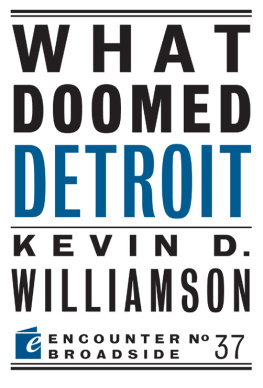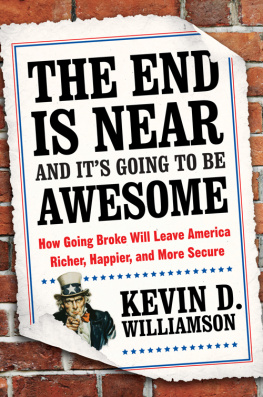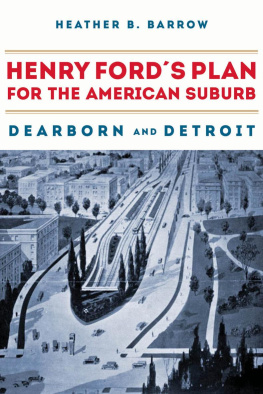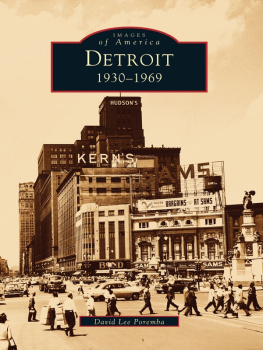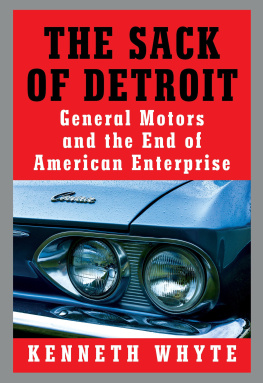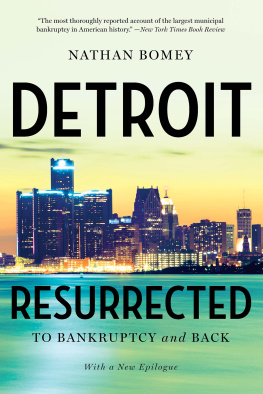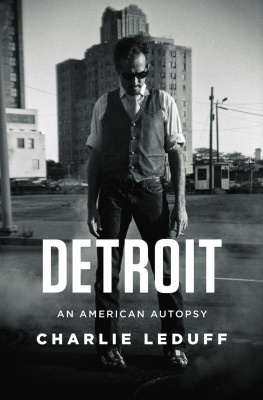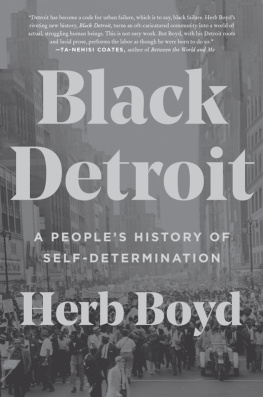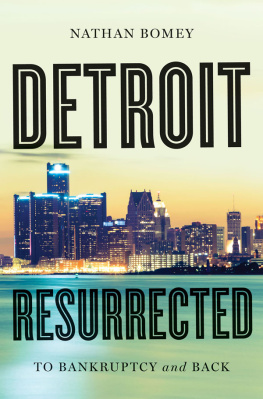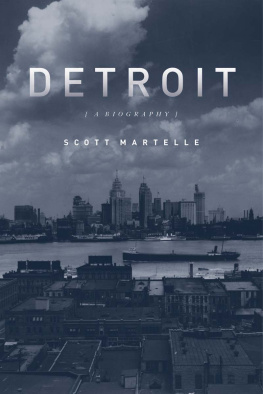
ENCOUNTER BROADSIDES : Inaugurated in the fall of 2009, Encounter Broadsides are a series of timely pamphlets and e-books from Encounter Books. Uniting an 18th century sense of public urgency and rhetorical wit (think The Federalist Papers, Common Sense) with 21st century technology and channels of distribution, Encounter Broadsides offer indispensable ammunition for intelligent debate on the critical issues of our time. Written with passion by some of our most authoritative authors, Encounter Broadsides make the case for ordered liberty and the institutions of democratic capitalism at a time when they are under siege from the resurgence of collectivist sentiment. Read them in a sitting and come away knowing the best we can hope for and the worst we must fear.

Better to reign in Hell than serve in Heaven
J OHN M ILTON , Paradise Lost
I N THE SPACE of a single generation, Detroit managed to ruin itself. Some of the factors that led to the immolation of Detroit are unique to the city and its politics, but some are not. As the nation watches the city descend into insolvency and chaos, the question is: Is Detroit an outlier, or is it just ahead of the curve?
The proximate cause of Detroits bankruptcy is its inability to make good on debts owed to the funds paying out pensions and health care benefits to current and retired city workers. Those obligations make up the great majority of Detroits $20 billion or so in outstanding debt. While the citys population has been plummeting since the 1950s, its public sector has continued to grow relative to the size of its population. In 2011, it maintained nearly 13,000 city employees, or one municipal employee for every 55 residents, twice the number of larger cities such as Charlotte and Fort Worth. (That one may write larger cities such as Charlotte and Fort Worth speaks volumes about what has become of Detroit.) When staffing reductions have been proposed, both the unions and city officials resisted. When modest reductions were proposed in 2011, city Finance Director Tom Lijana protested, You cant do this in one year. Im going to be picking up your garbage once a month. Im only going to turn on power to your house every once in a while. You just cant do that. Yet the city of Austin, hardly a Spartan outpost of small-government skinflintery, manages to provide what are generally conceded to be very good municipal services with far fewer city employees per resident than Detroit. San Jose does so with half the per capita municipal workforce that Detroit maintains.
Detroit is an extreme example of the fact that public-sector employment has become in effect a supplementary welfare state, with salaries and benefits and, above all, pensions entirely disconnected from legitimate municipal purposes. Unionized public-sector employees with a high degree of political discipline fortified by narrow financial self-interest become an unstoppable constituency, and the government becomes its own special-interest group. But while salaries more or less have to be paid out of current revenue and therefore impose at least a measure of pain on taxpayers, promised future benefits need not be backed by anything more than good intentions. While there were areas in which the city proceeded responsibly as late as 2011, its police and firefighter pension fund was being adequately provided for many future obligations were not funded at all, or funded to only a tiny degree of the liabilities accruing. A 2012 Kennedy School study found that Detroit had set aside less than half of what it would need to fund its pensions and was attempting to fund its health-insurance and life-insurance plans on a pay-as-you-go basis, resulting in unfunded liabilities amounting to a massive $5 billion.

Detroit is an extreme example of the fact that public-sector employment has become in effect a supplementary welfare state

In spite of these growing liabilities, Detroits public-sector workers consistently managed to increase their share of the citys workforce while stopping dead any and all efforts at meaningful reform.
They have been empowered to resist reform by a particularly nasty form of racialist politics that has reached its fullest expression in Detroit but is by no means limited to that unhappy city. When the mayor of Philadelphia boasts that the brothers and sisters are in charge, when the mayor of Washington declares the nations capital a chocolate city, they are cultivating the same sort of tribalism that has helped make Detroit what it is. The tolerance for black racism in American politics is striking. When Representative Joe Mitchell, an Alabama Democrat, was challenged by a constituent about a question related to gun rights, Mitchell responded that he was elected to represent the interests of blacks and maintained that he could care less about the interests of his white correspondent and those of his slave-holding, murdering, adulterous, baby-raping, incestuous, snaggle-toothed, backward-assed, inbreed [sic], imported, criminal-minded kin folk. The anti-Semitic remarks of the Rev. Jesse Jackson and the Rev. Al Sharpton are of course well documented, as is the habit of mostly Democratic black politicians of consorting with such openly racist demagogues as Louis Farrakhan. It is an irony of our history that the political home of black racism in American politics is also the historical political home of white racism: the Democratic Party.
The end point of such politics is Detroit. As late as 1960, Detroit was the most affluent city in the United States and perhaps the most affluent industrial city in the world with a per capita income exceeding that of any other U.S. city, according to the U.S. Census Bureau. In 1961, it elected as its mayor Jerome Cavanagh, a 33-year-old Democrat whose youth and idealism brought immediate and inevitable comparisons to John F. Kennedy. Cavanaghs triumph was a surprise, and he was borne to victory on the strength of an African-American vote whose power had not yet been fully appreciated. Added to the Democratic allegiances of Catholic white ethnics, the subordination of the conservative-voting autoworkers to their left-leaning union bosses, and the growing sympathy for Kennedy-Johnson-style progressivism among the professional classes, the attachment of the black vote to the Democratic cause meant the end of Republicans in Detroit and the establishment of a de facto one-party government.
The effects would prove catastrophic in a remarkably short period of time.
But Cavanagh entered office on a wave of optimism. He promised reform, and reform was needed and seemed within reach. Already in the 1950s and early 1960s, Detroit had troubles, but they were not insurmountable. Detroit, like many similar cities, had a problem: the concentration of poverty and related social dysfunction in its inner city in no small part a legacy of the explosion of the citys black population during the Great Migration, soaring from 6,000 in 1910 to 120,000 in 1929 and from 1.2 percent of the population in 1910 to about 30 percent of the population by the election of Cavanagh. It is one of the great tragedies of American history that wherever black Americans go, from the Jim Crow South to the great industrial cities, they are persecuted by the Democratic Party, then help entrench the power of that party.

